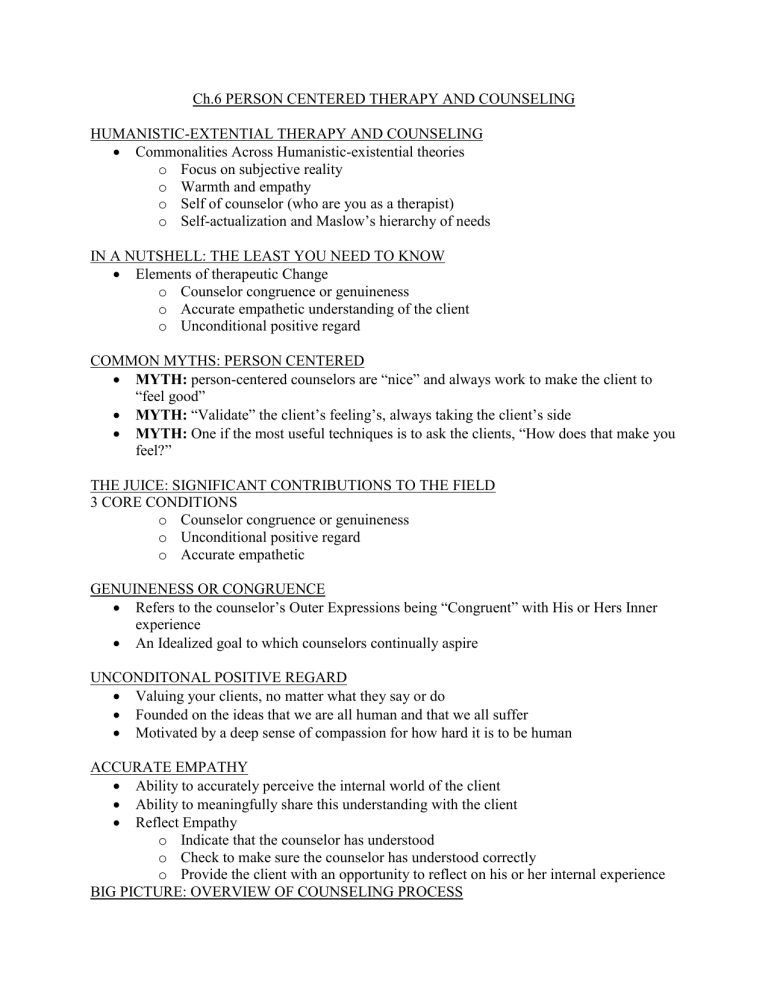
Ch.6 PERSON CENTERED THERAPY AND COUNSELING HUMANISTIC-EXTENTIAL THERAPY AND COUNSELING Commonalities Across Humanistic-existential theories o Focus on subjective reality o Warmth and empathy o Self of counselor (who are you as a therapist) o Self-actualization and Maslow’s hierarchy of needs IN A NUTSHELL: THE LEAST YOU NEED TO KNOW Elements of therapeutic Change o Counselor congruence or genuineness o Accurate empathetic understanding of the client o Unconditional positive regard COMMON MYTHS: PERSON CENTERED MYTH: person-centered counselors are “nice” and always work to make the client to “feel good” MYTH: “Validate” the client’s feeling’s, always taking the client’s side MYTH: One if the most useful techniques is to ask the clients, “How does that make you feel?” THE JUICE: SIGNIFICANT CONTRIBUTIONS TO THE FIELD 3 CORE CONDITIONS o Counselor congruence or genuineness o Unconditional positive regard o Accurate empathetic GENUINENESS OR CONGRUENCE Refers to the counselor’s Outer Expressions being “Congruent” with His or Hers Inner experience An Idealized goal to which counselors continually aspire UNCONDITONAL POSITIVE REGARD Valuing your clients, no matter what they say or do Founded on the ideas that we are all human and that we all suffer Motivated by a deep sense of compassion for how hard it is to be human ACCURATE EMPATHY Ability to accurately perceive the internal world of the client Ability to meaningfully share this understanding with the client Reflect Empathy o Indicate that the counselor has understood o Check to make sure the counselor has understood correctly o Provide the client with an opportunity to reflect on his or her internal experience BIG PICTURE: OVERVIEW OF COUNSELING PROCESS TREATMENT o Process-Oriented Approach o Meaning that the counselor’s attention is on the how things happen (process) rather than what happens (content) o Focuses on How the client interacts with self, others, and life challenges SEVEN STAGES OF CHANGE PROCESS 1st stage: a person’s personality seems fixed, personal problems are not acknowledged 2nd stage: he or she begins to loosen up and is more open to seeing problems 3rd stage: express past feelings and personal meanings 4th stage: becomes more open to reconsidering their construct about self and others, increasing able to verbalize deep emotions 5th stage: they are increasingly able to verbalize in-the -moment emotions and experiences 6th stage: is now bale to experience difficult emotions as they arise with acceptance 7th stage: this stage generally occurs outside the counseling relationship MAKING CONNECTION: COUNSELING RELATIONSHIP THERAPEUTIC RELATIONSHIP Relationship as change agent o Views the relationship as two authentic humans in relationship Therapeutic Presence and the Core Conditions o Therapeutic Presence: way of being in the room o Create something far greater and more powerful in the relationship The Viewing: Case Conceptualization Experiencing and communication of Self Recognition of Feelings Expression of Emotion Present Moment Experiencing Personal Constructs and Facades Complexity and Contradictions Perception of Problems and Responsibility Peak Experience and Flow Targeting Change: Goal Setting Self-Actualization o “Becoming that self which one truly is” o Refers to fulfilling one’s potential and living an authentic, meaning life o Believed that humans naturally tend toward positive, prosocial growth o Long-term, late phase goal Process Goals o Identify areas of growth o Process issues: a person’s internal process THE DOING: INTERVENTIONS Self of the Counselor & core conditions (who or how you are in the room) Focused listening or attending (nonverbal, nodding head, listening to client) Summarizing (key elements, emotional train that they describe) Clarifying (asking for details so you can understand what was going on, emotions) Reflecting feelings (identify the emotion train, reflecting it back to client) Process questions (identify the feeling, what are they feeling like right now) Concreteness and Specificity (what is sadness/ grief…) Self-Disclosure (need to be trusted) Confrontation (help point it out) Immediacy (how they feel in the moment) Focusing (help them focus on the core process area and recognize them in life) WHAT NOT TO DO Use reassuring clichés Give advice Request an explanation Agree with the client Disagree with the client Give approval Express disapproval INTERVENTIONS FOR SPECIAL POPULATIONS Nondirective play therapy o Eight principles of axline’s play therapy o Children who experience trauma Expressive arts therapy- a way to express their internal process to their world RESEARCH AND THE EVIDENCE BASE Research o Process research The study of in-session counseling processes that promote or hinder change o Evidence Base Treatments Emotionally focused couples therapy o Common Factors Research Rogers’ core conditions Counseling relationship accounting for 30% of outcome variance TAPESTRY WEAVING: APPLICATIONS WITH DIVERSE POPULATIONS DIVERSITY Culture/Gender Competence o Considering culture/gender norms of emotional expression o Consider individualist vs, collectivist values Sexual Identity Diversity o Focus on the burden of societal rejection of the client’s authentic self o “coming out” a part of self-actualization

